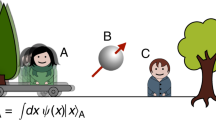Abstract
It is proposed that quantum mechanical systems may spontaneously develop collective modes and other cooperative behavior which lead to a rich structuring of their Hilbert spaces and the consequent appearance ofobjective parameters for their description, in addition to the more familiar wave function description. The paper discusses the time evolution of these objective parameters, both the terms of non-unitary operators and through the dynamical effects of the quantum system's environment. A brief exploration is also made of the way in which the objective parameters corresponding to two quantum systems can “measure” and interact with each other. The significance of a non-unitary time evolution for the origin of the universe is also discussed.
Similar content being viewed by others
References
A recent overview of David Bohm's approach can be found in the general introduction toQuantum Implications: Essays in honour of David Bohm (Routledge & Kegan Paul, London and New York, 1987) and in Bohm's own essay, which can be found on pages 33–45 of that book.
See, for example, D. Bohm, B. J. Hiley and P. N. Kaloyerou,Phys. Rep. 144, 323, 349 (1978).
D. Bohm and B. J. Hiley,Phys. Rev. Lett. 55, 2511, (1985).
F. D. Peat,Int. J. Quant. Chem., Quantum Biology Symposium 1, 213 (1974).
F. D. Peat,Collective Phenomena 2, 149 (1976).
R. Penrose, inQuantum Concepts in Space and Time, R. Penrose and C. J. Isham, eds. (Oxford Univ. Press, Oxford, 1985).
D. Bohm and D. Pines,Phys. Rev. 85, 338 (1952); and92, 609 (1953).
D. Bohm and B. Hiley, inQuantum Mechanics vs Local Reality: The E.P.R. Paradox, F. Selleri, ed. (Plenum, New York, 1988), p. 235.
D. Bohm and G. Carmi,Phys. Rev. 133, A319, A332 (1964).
P. T. Landsberg,Thermodynamics (Interscience Publishers, New York, London, 1961).
R. Penrose, inGeneral Relativity: An Einstein Centenary Survey, S. W. Hawking and W. Israel, eds. (Cambridge University Press, Cambridge, 1979), p. 581.
R. Penrose, inQuantum Theory and Beyond, T. Bastin, ed. (Cambridge University Press, Cambridge, 1971), p. 151.
Author information
Authors and Affiliations
Rights and permissions
About this article
Cite this article
Peat, F.D. Time, structure, and objectivity in quantum theory. Found Phys 18, 1213–1231 (1988). https://doi.org/10.1007/BF01889433
Received:
Issue Date:
DOI: https://doi.org/10.1007/BF01889433




